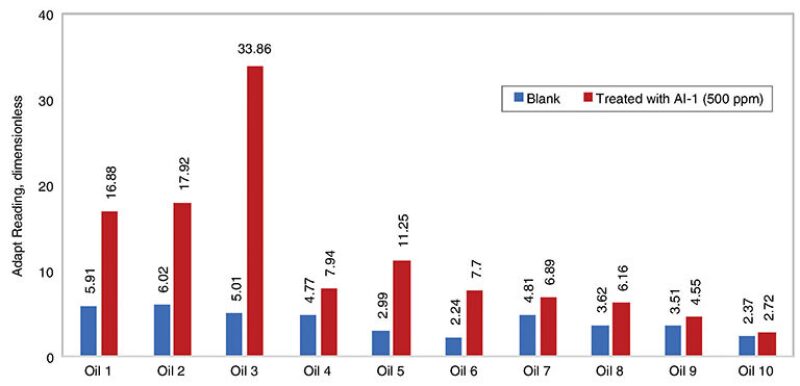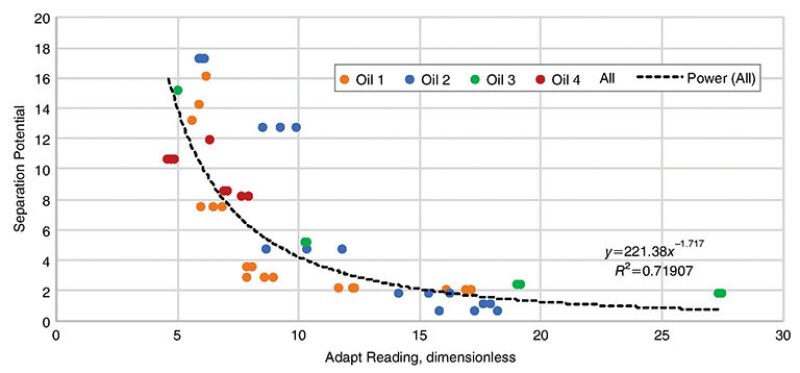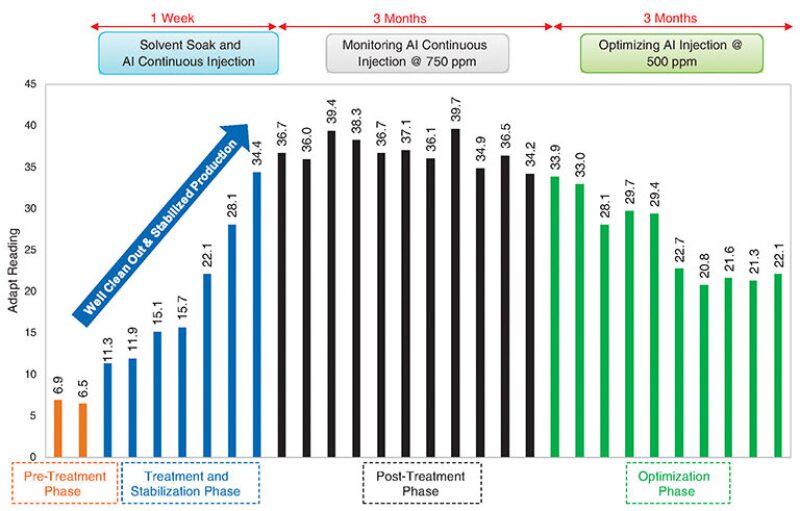Asphaltenes represent a highly polar component of crude oil, insoluble in n-alkanes and soluble in aromatic solvents. The interactions between asphaltene-water, asphaltene-clay, or asphaltene-asphaltene molecules can cause severe flow assurance issues in an oil field. Such issues could lead to pore-throat blockages within the reservoir and the plugging of production and transportation flowlines.
To overcome these issues, it is necessary to first understand the overall stability and dispersancy state of the asphaltenes within the native crude.
Most techniques currently used are based on light-scattering and transmittance phenomenon. Since crude oils are intrinsically dark colored, these techniques require dilution of the oil sample with solvents or precipitants. The addition of these chemicals alters the nature and thermodynamic equilibrium of the various solubility fractions within the crude oil. Moreover, the performance of asphaltene inhibitor (AI) on low-asphaltene crude oil samples is very difficult to analyze using traditional optical transmission methods.
Researchers from Clariant Oil Services have recently created a more efficient method to evaluate asphaltene stability and inhibitor efficiency using native crude oil samples. This technique can overcome the limitations associated with the optical transmission method. It also presents a more realistic approach to understanding asphaltene stability since it investigates the state of asphaltene within the native crude oil medium rather than the pseudo system of oil precipitant.
A Novel Technique
For the first time, AI performance is being evaluated by measuring the thermo-electric properties of the native crude oil medium using asphaltene differential aggregation probe test, or ADAPT methodology. For the performance testing part of this work, asphaltene inhibitors were examined. Analyzing multiple crude oil samples with a high degree of variation provides the opportunity to foster a better understanding of asphaltene behavior in bulk crude oil samples. It enables the development of a universal testing method for assessing asphaltene stability and inhibitor performance. It is important to note that interactions between crude oil constituents and a given AI formulation are specific since each oil sample may respond differently. To corroborate this behavior using ADAPT, one of Clariant’s AI formulations (AI-1) was tested together with 10 crude oil samples as shown in Fig. 1, where blank and treated crude oil samples are represented with blue and red bars, respectively. Fig. 2 shows the ADAPT readings for the blank (blue bars) and treated (red bars) crude oil samples. The blank oil samples have a minimum reading of 2.24 units for Oil 6 as compared to the maximum value measured of 6.02 units for Oil 2. The addition of 500 ppm of AI-1 formulation to each of the crude oil samples increased overall asphaltene dispersancy and resulted in higher ADAPT readings.


Results from ADAPT were also validated by comparing AI performance trends against the industry-accepted, traditional optical dispersancy test with n-alkanes as precipitant. A comparative assessment of ADAPT and optical method results is shown in Fig. 2. Performance efficiency of an AI on four test oil samples was measured using ADAPT as well as the optical transmittance method. An inverse relationship exists between the ADAPT reading (x-axis) and the separation potential (optical transmission parameter on y-axis). However, it is important to note that this inverse correlation is nonlinear. Accordingly, the separation potential is seen to decrease with increasing ADAPT readings until it hits a minimum range beyond which the amount of asphaltene separation forced by the conditions of the settling test (heptane dilution, gravitational/centrifugal force, tube length, and test duration) is nondifferentiable. Conversely, the ADAPT measurements are independent of these test conditions as they are carried out in native crude oil media.
To build the credibility and robustness of this new testing method, the in-field application of ADAPT was performed on an offshore platform to monitor and optimize an ongoing asphaltene treatment job. The following section describes the field application study using ADAPT as a monitoring tool to evaluate overall asphaltene dispersion.
Field Application
A dry-tree well from the deepwater Gulf of Mexico was experiencing blockages and flow restrictions due to asphaltene deposition. The well was perforated between 17,700 and 18,000 ft, while the downhole chemical injection mandrel was situated at 14,600 ft, resulting in 3,400 ft of unprotected tubing. Since the asphaltene onset pressure of the producing fluid was high and within the reservoir conditions, the near-wellbore and lower, unprotected tubing were susceptible to asphaltene deposition. To prevent blockage of the tubing and loss of production, annual coiled-tubing cleanouts were performed along with a continuous AI injection. For this work, asphaltene stability and inhibitor performance efficiency were evaluated using produced fluid collected over a 1-year period and flowback samples taken from remediation and cleanup stages.
An estimation of the blockage caused from asphaltene deposition was evaluated using a transient multiphase flow model, which indicated reduction of the production tubing internal diameter from 2.3 to 1.35 in. Thus, a remediation job was designed to include solvent soak and a continuous AI injection to manage the asphaltene deposition downhole in the production tubing and flowlines. An aromatic solvent with chemical dispersant was squeezed 2.2 in. radially into the near-wellbore region and allowed to soak for 2 days. Following soaking, production was re-established with a continuous injection of a best-performing AI at 750 ppm, which was further optimized to a lower dosage after initial application.
Field Monitoring and Stimulation Job Response
Based on the laboratory testing, a remediation job was designed to clean up the asphaltene deposit present in the near-wellbore and production tubing. The remediation program included a solvent soak for 2 days followed by a flowback of the well with continuous AI-1 injection at a high dose rate of 750 ppm. A portable ADAPT unit was shipped to the offshore facility, and periodic monitoring of the produced fluid at the wellhead was performed. The very first readings, highlighted in orange in Fig. 3, were obtained just before the remediation job was initiated and prior to AI treatment. These samples had very low ADAPT readings (average 6.7). After the soaking period, the well was brought on line with a continuous AI-1 injection at 750 ppm. The well-cleanout and stabilized production samples are highlighted by blue bars in Fig. 3, which represent the flowback samples. As shown, these samples follow an incremental trend of increasing ADAPT readings. This is primarily because the flowback samples consisted of solid asphaltene deposits being carried within the solvent medium in a dissolved or dispersed state, leading to an increase in the ADAPT response. Moreover, the continuous AI-1 injection also enhanced the asphaltene dispersibility of the colloidal medium.
Once the stabilized flow was established, the effect of only an AI-1 injection at a constant dose rate should be reflected on the ADAPT reading, as highlighted by the black bars in Fig. 3. After monitoring the field response at higher AI-1 dosage for a duration of 3 months, the additive concentration was reduced to 500 ppm. The samples analyzed during the concentration stepdown stage are shown in the green bars in Fig. 3. The ADAPT response followed the expected trend with a decrease in the readings to around 21 at 500-ppm dosage. This remediation job improved the ΔP/Q (pressure drop over production flow rate) for this well and resulted in 16% overall increase in production (including overall shut-in time) over a 4-month period.

Conclusions
The study presented a novel and efficient technique to evaluate asphaltene stability and inhibitor efficiency in native crude oil. The thermo-electric properties measured for different crude oil and inhibitor mixtures demonstrated that the ADAPT method can accurately measure the disaggregation or dispersancy state of asphaltenes within the colloidal matrix. Positive correlations between the laboratory measures and field-optimized readings indicate the validity of the technique. Moreover, comparative assessments of the described test method, with the widely used optical-transmittance technique, highlights major advantages of using ADAPT in terms of its wide applicability toward crude oil matrices that consist of low asphaltene content.

Jonathan Wylde is global head of innovation at Clariant Oil and Mining Services, and honorary associate professor, Heriot-Watt University. He is responsible for global application development and innovation at Clariant and has authored more than 150 papers and patents. He has served on SPE committees for the International Scale Conference, Oilfield Chemical Symposium, and Annual Technical Conference and Exhibition (ATCE), and is currently a technical editor for SPE JPT, SPE Production and Operations, and the SPE Journal.

Abhishek Punase is an application scientist, asphaltenes at Clariant Oil and Mining Services. He is responsible for application development and innovation related to flow assurance issues caused by asphaltenes instability. He has contributed 25 technical papers and patents to the scientific community and peer reviewed articles for journals including Energy and Fuel, British Journal of Science and Technology, and Journal of Applied Chemical Science International.
